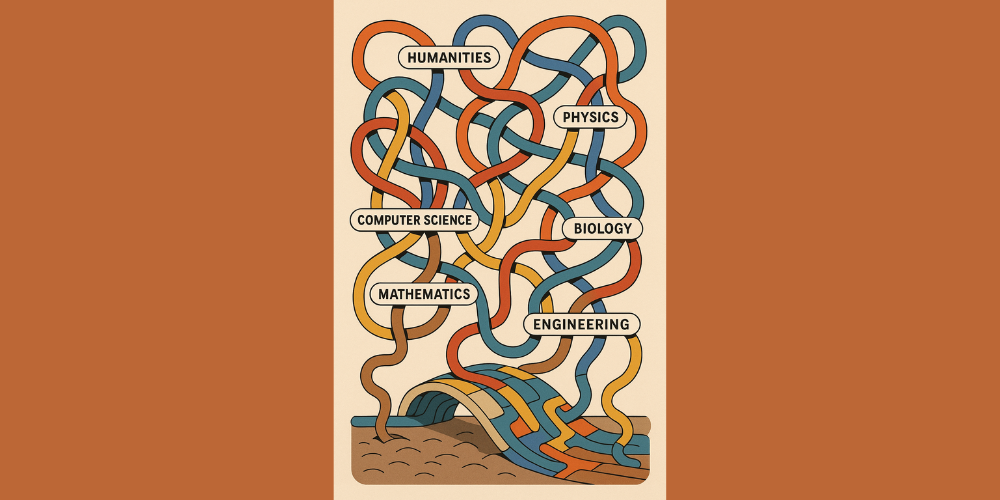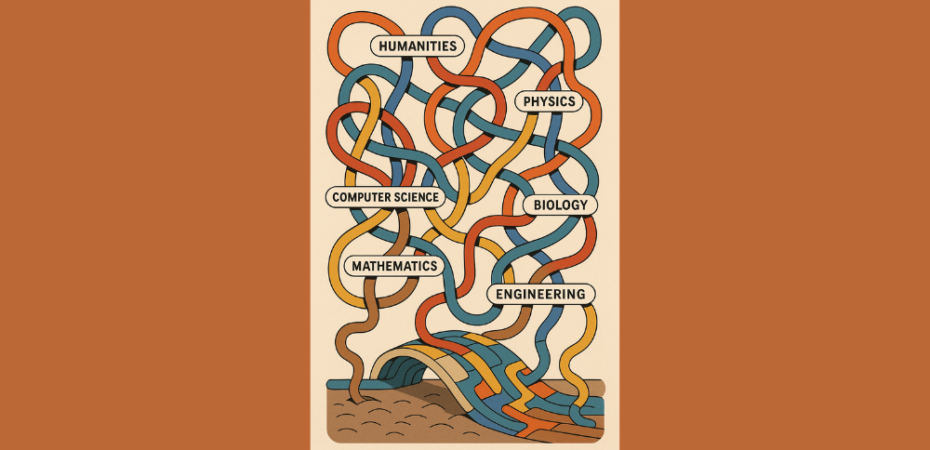
In this blog post, Samantha Banner explores two of the most persistent challenges in interdisciplinary research: communication breakdown and methodological conflicts. She uses the COVID-19 global pandemic as a real-world example, where the lack of cohesive interdisciplinary collaboration arguably cost the world time, funding and lives. Samantha is a second-year undergraduate student studying Interdisciplinary Future. This post belongs to the ‘Navigating complexity through interdisciplinary teaching and learning‘ Hot Topic series.
Interdisciplinary research is gaining traction in academic circles. But what is driving the conversation and what do we mean by interdisciplinary research? According to The National Academies, interdisciplinary research is a form of inquiry that blends insights, tools and perspectives from multiple fields to tackle complex problems that no single discipline can solve. So rather than viewing issues through one lens, you consider multiple different lenses. Therefore, solutions are beyond the scope of a single discipline or area of research practice.
Researcher, Gabriele Bammer, studies the profound need for interdisciplinary research as a result of four drivers:
- The inherent complexity of nature and society
- The desire to explore problems and questions that are not confined to a single discipline
- The need to solve societal problems
- The power of new technologies
Interdisciplinary research hasn’t always enjoyed the spotlight that it holds today, especially within education, where it’s being framed the ‘future of education’ by many academics. The principles of interdisciplinarity have always been present but never defined until the 20th century. Historically, the term used to describe someone skilled across disciplines would be a generalist.
Two of the most persistent challenges in interdisciplinary research, however: communication breakdown and methodological conflicts.
Communication breakdowns
Communication is the key component of successful research, yet it’s one of the greatest challenges, especially across disciplines. Different disciplines often speak entirely different ‘languages’, shaped by their terminology, assumptions and methods.
When scientists communicate with the public, they risk a less precise scientific knowledge output by finding a simplified, common ground within their communication. This same challenge is apparent within interdisciplinary research where effective collaboration depends on researchers being able to reiterate their disciplinary language to be understood by those outside of their field. Someone with an interdisciplinary background, which educational institutions are currently pursuing, would be of value as a team leader, to correct these misunderstandings and manage the barriers being faced. Hopefully, as more institutions invest in interdisciplinary education, these roles will be sought after.
Historically, the sciences have often been regarded as superior to the humanities in an academic hierarchy – a longstanding and contentious debate. However, this divide highlights the need for interdisciplinary collaboration, specifically within addressing global challenges.
When science and humanities intersect, they can create a hierarchical structure with power imbalances that influence how certain issues are communicated and prioritised. But, if this is managed properly, this crossover can produce more holistic and effective solutions.
For instance, the scientific sector will typically provide insight into what the issue is and how it has emerged, offering the foundational knowledge. Meanwhile, the humanities contextualise the problem, exploring why this is an issue, who it’s impacting and how the solution can be applied. Both perspectives are essential in developing robust strategies to manage global challenges, delivering a much better outcome.
Methodological conflicts
Depending on a researcher’s discipline, qualitative and quantitative data are often valued and interpreted very differently. Returning to the debate of science-versus-humanities, disciplines such as social anthropology rely heavily on qualitative ethnographic methods, which are sometimes deemed as ‘softer’ data compared to quantitative, statistical studies.
Disregarding this debate, both methodologies have distinct challenges. Qualitative research is often more difficult to carry out and manage – requiring years, or even lifetimes of precise data collection, this can emit conflict within timelines of research goals.
On the other hand, quantitative data can be collected and processed more efficiently through computer systems. These differences in methodologies means that conflicts can occur where the research hasn’t been planned out to full coordination from the onset. Aligning on a clear research question, shared expectations, and a realistic time frame can dramatically mitigate these conflicts affords the strengths of both approaches to shine.
The COVID-19 Pandemic: Real-world case of communication breakdown and methodological conflict
In Gabriele Bammer’s publication of Disciplining Interdisciplinarity, she argues that the reasoning for interdisciplinary research often failing – specifically when addressing global challenges – is due to fragmentation, unorganised diversity, and disciplinary dogma. While there are strategies to overcome these challenges, the difficulty lies in accommodating the full range of knowledge systems and perspectives involved.
For those unfamiliar with interdisciplinary research, it can initially appear as a far-fetched, overly theoretical concept. In reality, it’s already played a critical role in shaping the past, including one of the most urgent global crises of recent times: the COVID-19 pandemic.
During the early stages of the pandemic, conflicting views emerged across scientific disciplines, particularly over whether the virus was airborne or not. This meant that some countries acted early and implemented policies to avoid close contact between people, and other countries had a delayed reaction and did not adopt this knowledge, ultimately increasing spread.
This lack of consensus wasn’t just a failure of communication, but an example of interdisciplinary friction. Researchers now believe that if these different scientific disciplines collaborated within their research of the pandemic, this contestation through challenging each other’s assumptions constructively would have motivated each discipline into new knowledge and produced faster, better, more coordinated response. For example, the technology and policy decisions aimed at reducing airborne transmission of COVID-19, such as improved ventilation systems or real-time air quality monitors, might have evolved quicker if disciplines had integrated their insights earlier in the process.
Conclusion
The assembling of multiple disciplines to solve a shared problem was never going to be easy. Put a group of experts in a room – each with their own priorities, methods and ways of thinking – and conflict is inevitable.
At first glance, it might seem unproductive. But when these differences are acknowledged, navigated and managed, they become a source of strength rather than disruption. Through having the right structure, the potential and opportunities for interdisciplinary research are limitless.
In modern research teams, the key component is your interdisciplinary leader – or generalist. They oversee skillsets, manage timeframes and navigate communication or conceptual barriers between disciplines. Whether acting as a team leader or a project manager, this figure is essential for bridging gaps and preventing misalignment in language, methodology or expectations. This role also ensures balance to create a rounded recommendation.
With interdisciplinary schools and courses on the rise, we’re seeing the emergence of a new generation of research leaders and project managers – individuals equipped with the tools to understand, translate and mitigate these disciplinary tensions effectively, which is a great opportunity to be a part of!
 Samantha Banner
Samantha Banner
Samantha Banner is currently a second-year undergraduate student studying Interdisciplinary Futures at the University of Edinburgh and a member of the Edinburgh Futures Society committee. Her blog post explores the challenges faced by interdisciplinary research teams, as well as the reasons why these teams are so necessary in addressing modern global challenges.


